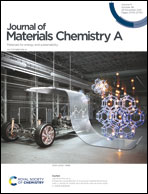High-throughput computation of novel ternary B–C–N structures and carbon allotropes with electronic-level insights into superhard materials from machine learning†
Abstract
Discovering new materials with desired properties has been a dominant and crucial topic of interest in the field of materials science in the past few decades. In this work, novel carbon allotropes and ternary B–C–N structures were generated using the state-of-the-art RG2 code. All structures were fully optimized using density functional theory with first-principles calculations. Several hundred carbon allotropes and ternary B–C–N structures were identified to be superhard materials. The thermodynamic stability of some randomly selected superhard materials was confirmed by evaluating the full phonon dispersions in the Brillouin zone. The new carbon allotropes and ternary B–C–N structures possess a wide range of mechanical properties generally and Vickers hardness specifically. Through 2D Pearson's correlation map, we first reproduced the well-accepted explanation and relationship of the Vickers hardness of the generated structures with other mechanical properties such as shear modulus, bulk modulus, Pugh's ratio, universal anisotropy, and Poisson's ratio. We then propose two fundamentally new descriptors from the electronic level, namely local potential and electron localization function averaged over a unit cell, both of which exhibit a strong correlation with Vickers hardness. More importantly, these descriptors are easy to access from first-principles calculations (at least two orders of magnitude faster than the traditional calculation of elastic constants), and thus can serve as a fast and accurate approach for screening superhard materials. We also combined these new descriptors with known composition and structural descriptors in the machine learning training process. The new descriptors significantly enhance the performance of the trained machine learning model in predicting the Vickers hardness of unknown materials, which provides strong evidence for local potential and electron localization function to be considered in future high-throughput computation. This work unravels more fundamental but previously unexplored knowledge about superhard materials and the newly proposed electronic level descriptors are expected to accelerate the discovery of new superhard materials.



 Please wait while we load your content...
Please wait while we load your content...